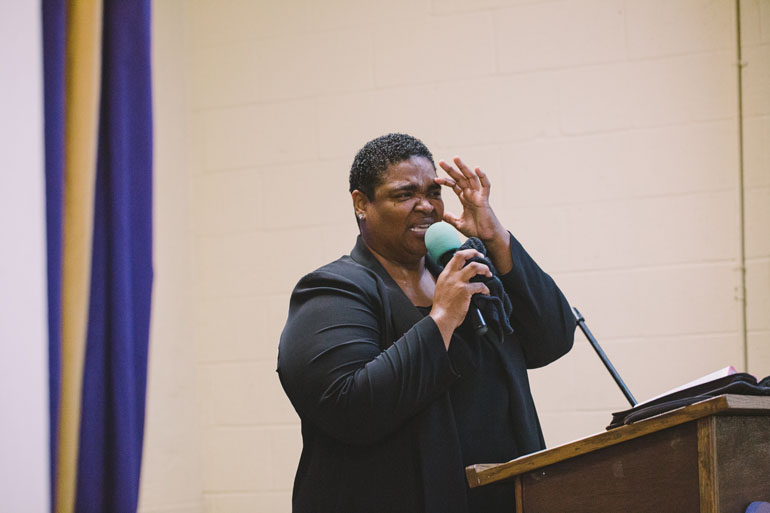OAKLAND, Calif. — For Rev. Donna Allen’s congregation in West Oakland, the New Revelation Community Church is a place to share with other African-Americans and to find support when facing life’s small and big crises. And for Allen, one of the most important messages is that their community has too often ignored the scourge of mental illness.
“They’ll describe being very depressed, like ‘I don’t want to go on. I don’t want to get out of bed, I don’t want to live anymore,’ ” said Allen. “They’re really describing things that are mental health issues.”
She is trying to strengthen the community response to the needs of others and make sure church members understand that it’s not just faith that they can lean on when facing mental health problems. It’s an effort promoted by Alameda County, which has invested more than $1 million to help faith communities and other groups to bring mental health services to underserved communities.
Allen’s church has secured nearly $5,000 of that money to train congregants about how to help their peers with mental illness.
“When you talk to people and say who is the leader in your community, typically they say the ‘faith leaders,’ ” said Gigi Crowder, the ethnic services manager at Alameda County Behavioral Health Care Services.
So the county has focused specifically on churches, inviting religious leaders to roundtable discussions about mental health and funding workshops to help congregants reach out to one another.
Churches can be particularly helpful in African-American communities where the need for mental health services is great but access often is limited. In general, African-Americans are 20 percent more likely to experience serious mental health problems than non-Hispanic whites, yet only 7.6 percent of black people sought treatment for mental health concerns, according to the Department of Health and Human Services. That contrasts with 13.6 percent of the general population that has received treatment.
Just a year ago, the American Psychological Association published a study that found “significant barriers to mental health services” remain for minority populations, even though the problem has been studied for more than a decade. Dr. David Satcher, while surgeon general, issued a landmark report in 2001 that found minority groups generally had poorer quality mental health care than whites.
Allen said she is hoping that by talking about mental health issues and helping to get members of her congregation trained, people “will be less likely to ignore, less likely to walk away, to minimize.”
Allen knows firsthand how debilitating that can be. “I’m up front with them that I see a therapist,” she said. “I share with them that I’ve had periods of depression — not saying that I’m going through what you’re going through, but I at least can identify.”
She hugs her congregants, she visits their houses, she offers her support. She gives them an opportunity to open up about very personal things that affect mental health, something she says the black church has not always embraced.
“I think it helps, especially if I don’t have the stigmas and I don’t have issues with someone having a mental health condition,” she says. “The next step is connecting them with resources and following up with them, encouraging them” to get treatment.
So far, her church has held two training sessions for interested congregants on how to handle a mental health crisis.
During the day-long sessions, church members learn how to recognize and assist someone who needs help.
“Mental disorders can cause disability across a person’s life span and this is why it’s important to detect problems early and ensure the person is properly treated,” says Naki-Ta Thomas, a church member and co-facilitator for the workshop.
At their latest training session last summer, the group divided into groups of three for an exercise designed to show what experiencing a schizophrenic episode could be like. One of the participants asked another a constant barrage of basic questions, such as what is your name, where do you work. At the same time, another participant said distracting things through a funnel positioned in the ear of the person trying to answer the questions. “Don’t trust him!” the woman with the funnel said. “He’s looking at you, why is he looking at you? Why would he want to talk to you? He’s looking at you!”
Later in the session, Allen points out to the participants that the first instinct when dealing with a person affected by a mental health crisis might be to call the police. Unless there is an immediate threat, that may not be the best choice, she said, because it could “escalate the situation.” That can be especially dangerous in minority communities where distrust and fear on both sides can lead to violence.
“It leads people of color to some dire consequences, in terms of being killed, injured or incarcerated as opposed to them getting the treatment that they need for the mental disorder,” Allen said.
As an alternative, she suggested to people being trained that they should consider a 24-hour crisis prevention telephone hotline or a suicide hotline phone number.
Yvette Frazier, one of Allen’s congregants in the training, put those numbers on her cellphone.
“I think that it’s important to recognize,” she said, “that when someone is having some difficulties in church we don’t get scared and run away, regardless of whatever their disorders may be.”
This article was produced as a project for the California Health Journalism Fellowship, a program of the Center for Health Journalism at the USC Annenberg School for Communication and Journalism. It originally aired on KALW.








